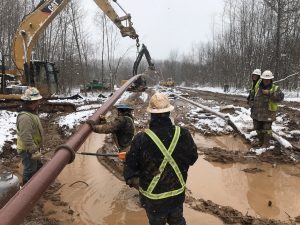Pipeline HDD in Winter

Exit side of bore after substantial rain events and melting.
When we think of unforeseen challenges of horizontal drilling, we usually think of challenges underground; fractured rock, gravel and cobble, lost drilling mud, etc. However, the challenges can just as easily be things that happen above ground. Weather is one great example of above ground challenges we face when installing HDD in the winter months.
This typified the three 850′ long, side-by-side gas pipeline bores DTD completed this January. The weather was the most challenging obstacle our crew had to deal with during this project. Temperatures plummeted below 10 degrees as the project started and then rose again with massive amounts of rain. With the drastic changes in temperature, the frozen ground quickly thawed and became cold, thick mud. The combination of thawing ground and rain fall created marginal access for the crew to both the entry and exit side. The entry side had to be matted and the exit side was only accessible by tracked equipment. This was mostly due to limited access along a mile of pipeline ROW. “Not only do you focus on the drilling process, but you must also coordinate with the pipeline contractor maintain access and support for fuel, supplies, and personnel” said Drilling Superintendent Jason Houseton describing the changing ROW conditions.

Pullback day.
As with any company that operates outside during the cold winter months, preparation and planning is key. Understanding the changing weather conditions and how it may impact drilling operations is vital in keeping projects and schedules running on time. The time of year, site specific project location (on a hill, in a valley, etc) and seasonal weather expected should all be taken into consideration when planning your next environmental or utility HDD project.